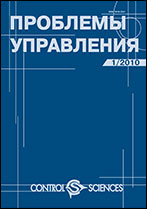|
Information technologies controls
Application of semiotic models to decision-making
A. A. Kulinich
Trapeznikov Institute of Control Sciences, Russian Academy of Sciences, Moscow, Russia
Abstract:
This paper introduces an approach to building decision support systems based on a semiotic domain model and natural language processing methods. The knowledge base of this model is a text corpus of linguistic information obtained from the Internet. The text corpus is relevant to the subject domain in which the subjective semiotic model of the situation is constructed. A method for solving the inverse problem in a semiotic system is proposed. The obtained solutions are interpreted in the subject domain using a semantic calculator. The semantic calculator extracts generic relations from the text corpus based on lexico-syntactic patterns and determines the frequency of joint occurrence of words in the solution based on the distributive analysis of the text corpus. The generalized structures of monitoring and decision-making sub-systems with the semiotic model of the situation and natural language processing methods are described. A software layout of the decision-making subsystem is developed. The effectiveness of this approach is demonstrated by experiments.
Keywords:
decision-making, semiotic system, subjective model, natural language processing, distributive analysis.
Received: 01.03.2022
Revised: 01.11.2022
Accepted: 22.11.2022
Citation:
A. A. Kulinich, “Application of semiotic models to decision-making”, Probl. Upr., 2022, no. 5, 40–59; Control Sciences, 2022, no. 5, 34–50
Linking options:
https://www.mathnet.ru/eng/pu1291 https://www.mathnet.ru/eng/pu/v5/p40
|

| Statistics & downloads: |
| Abstract page: | 81 | | Russian version PDF: | 23 | | English version PDF: | 60 | | References: | 18 |
|




 Contact us:
Contact us: Terms of Use
Terms of Use
 Registration to the website
Registration to the website Logotypes
Logotypes








 Citation in format
Citation in format 